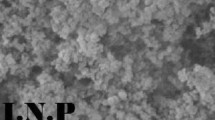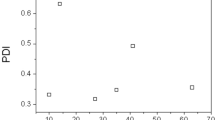Abstract
A study was carried out to investigate the effects of nano-silver particles (AgNPs) or silver nitrate (AgNO3) supplementation to in vitro culture of potato plant. Results indicated that 2 mg l−1 of AgNPs or AgNO3 treatment resulted in improvement in some growth parameters such as dry weight, root length and leaf area. However, shoot length was significantly reduced. Total chlorophyll and carotenoids in treated explants were significantly increased. Anthocyanin content increased only in AgNO3 treatments in a dose-dependent manner, while AgNPs treatments at 2 mg l−1 and higher levels increased and decreased, respectively. Compared with untreated explants, treated explants exhibited no alteration in proline content at 2 mg l−1 but increased at 10 and 20 mg l−1 treatments. Flavonoids content increased only in explants treated with 2 mg l−1 of AgNPs. Total phenolics were significantly increased under all treatments compared with untreated explants. AgNPs and AgNO3 treatments showed an increase in H2O2 content and lipid peroxidation under 10 and 20 mg l−1. Lipid peroxidation and H2O2 contents in explants treated with AgNPs were remarkably higher than in case of AgNO3. Results showed that AgNPs treatment enhanced growth of potato explants, which could possibly be due to inhibitory effects of silver ion on ethylene perception. Furthermore, AgNPs exhibited stronger toxicity than AgNO3 at 10 and 20 mg l−1 concentrations.





Similar content being viewed by others
References
Abdi, G., Salehi, H., & Khosh-Khui, M. (2008). Nano silver: A novel nanomaterial for removal of bacterial contaminants in valerian (Valeriana officinalis L.) tissue culture. Acta Physiologiae Plantarum, 30(5), 709–714.
Bates, L. S., Waldren, R. P., & Teare, I. D. (1973). Rapid determination of free proline for water-stress studies. Plant and Soil, 39(1), 205–207.
Ben Rejeb, K., Abdelly, C., & Savouré, A. (2014). How reactive oxygen species and proline face stress together. Plant Physiology and Biochemistry, 80, 278–284.
Beyer, E. M. (1976). A potent inhibitor of ethylene action in plants. Plant Physiology, 58(3), 268–271.
Chang, C.-C., Yang, M. H., Wen, H. M., & Chern, J. C. (2002). Estimation of total flavonoid content in propolis by two complementary colorimetric methods. Journal of Food and Drug Analysis, 10(3), 178–182.
Cho, K.-H., Park, J.-E., Osaka, T., & Park, S.-G. (2005). The study of antimicrobial activity and preservative effects of nanosilver ingredient. Electrochimica Acta, 51(5), 956–960.
Ehsanpour, A., & Jones, M. G. K. (2001). Plant regeneration from mesophyll protoplasts of potato(Solanum tuberosum L.) cultivar delaware using silver thiosulfate(STS). Journal of Sciences Islamic Republic of Iran, 12(2), 103–110.
Farago, M. E., & Mullen, W. A. (1979). Plants which accumulate metals. Part IV. A possible copper-proline complex from the roots of Armeria maritima. Inorganica Chimica Acta, 32, L93–L94.
Hatier, J.-H. B., & Gould, K. S. (2008). Foliar anthocyanins as modulators of stress signals. Journal of Theoretical Biology, 253(3), 625–627.
Heath, R. L., & Packer, L. (1968). Photoperoxidation in isolated chloroplasts: I. Kinetics and stoichiometry of fatty acid peroxidation. Archives of Biochemistry and Biophysics, 125(1), 189–198.
Hsiao, I. L., Hsieh, Y.-K., Wang, C.-F., Chen, I. C., & Huang, Y.-J. (2015). Trojan-Horse mechanism in the cellular uptake of silver nanoparticles verified by direct intra- and extracellular silver speciation analysis. Environmental Science and Technology, 49(6), 3813–3821. doi:10.1021/es504705p.
Karami Mehrian, S., Heidari, R., & Rahmani, F. (2015). Effect of silver nanoparticles on free amino acids content and antioxidant defense system of tomato plants. Indian Journal of Plant Physiology, 20(3), 257–263.
Kim, S. W., Kim, K. S., Lamsal, K., Kim, Y.-J., Kim, S. B., Jung, M., et al. (2009). An in vitro study of the antifungal effect of silver nanoparticles on oak wilt pathogen Raffaelea sp. Journal of Microbiology and Biotechnology, 19, 760–764.
Kowalska, I., Pecio, L., Ciesla, L., Oleszek, W., & Stochmal, A. (2014). Isolation, chemical characterization, and free radical scavenging activity of phenolics from Triticum aestivum L. aerial parts. Journal of Agricultural and Food Chemistry,. doi:10.1021/jf5038689.
Kumar, A., Prasad, M. N. V., & Sytar, O. (2012). Lead toxicity, defense strategies and associated indicative biomarkers in Talinum triangulare grown hydroponically. Chemosphere, 89(9), 1056–1065.
Laby, R. J., Kincaid, M. S., Kim, D., & Gibson, S. I. (2000). The Arabidopsis sugar-insensitive mutants sis4 and sis5 are defective in abscisic acid synthesis and response. The Plant Journal, 23(5), 587–596.
Lichtenthaler, H. K. (1987). Chlorophylls and carotenoids: Pigments of photosynthetic biomembranes. Methods in Enzymology, 148, 350–382.
Min, J. S., Kim, K. S., Kim, S. W., Jung, J. H., Lamsal, K., Kim, S. B., et al. (2009). Effects of colloidal silver nanoparticles on sclerotium-forming phytopathogenic fungi. The Plant Pathology Journal, 25, 376–380.
Monteiro, M. S., Santos, C., Soares, A. M. V. M., & Mann, R. M. (2009). Assessment of biomarkers of cadmium stress in lettuce. Ecotoxicology and Environmental Safety, 72(3), 811–818.
Murashige, T., & Skoog, F. (1962). A revised medium for rapid growth and bio assays with tobacco tissue cultures. Physiologia Plantarum, 15(3), 473–497.
Nair, P. M. G., & Chung, I. M. (2014). Physiological and molecular level effects of silver nanoparticles exposure in rice (Oryza sativa L.) seedlings. Chemosphere, 112, 105–113.
Purnhauser, L., Medgyesy, P., Czakó, M., Dix, P., & Márton, L. (1987). Stimulation of shoot regeneration in Triticum aestivum and Nicotiana plumbaginifolia Viv. tissue cultures using the ethylene inhibitor AgNO3. Plant Cell Reports, 6(1), 1–4. doi:10.1007/BF00269725.
Rodrıguez, F. I., Esch, J. J., Hall, A. E., Binder, B. M., Schaller, G. E., & Bleecker, A. B. (1999). A copper cofactor for the ethylene receptor ETR1 from Arabidopsis. Science, 283(5404), 996–998.
Schat, H., Sharma, S. S., & Vooijs, R. (1997). Heavy metal-induced accumulation of free proline in a metal-tolerant and a nontolerant ecotype of Silene vulgaris. Physiologia Plantarum, 101(3), 477–482.
Shams, G., Ranjbar, M., & Amiri, A. (2013). Effect of silver nanoparticles on concentration of silver heavy element and growth indexes in cucumber (Cucumis sativus L. negeen). Journal of Nanoparticle Research, 15(5), 1–12.
Sharma, P., Bhatt, D., Zaidi, M., Saradhi, P. P., Khanna, P., & Arora, S. (2012). Silver nanoparticle-mediated enhancement in growth and antioxidant status of Brassica juncea. Applied Biochemistry and Biotechnology, 167(8), 2225–2233.
Singleton, V. L., Orthofer, R., & Lamuela-Raventos, R. M. (1999). Analysis of total phenols and other oxidation substrates and antioxidants by means of Folin–Ciocalteu reagent. Methods in Enzymology, 299, 152–178.
Siripornadulsil, S., Traina, S., Verma, D. P. S., & Sayre, R. T. (2002). Molecular mechanisms of proline-mediated tolerance to toxic heavy metals in transgenic microalgae. The Plant Cell Online, 14(11), 2837–2847.
Sridevi, V., & Giridhar, P. (2014). In vitro shoot growth, direct organogenesis and somatic embryogenesis promoted by silver nitrate in Coffea dewevrei. Journal of Plant Biochemistry and Biotechnology, 23(1), 112–118.
Vannini, C., Domingo, G., Onelli, E., De Mattia, F., Bruni, I., Marsoni, M., et al. (2014). Phytotoxic and genotoxic effects of silver nanoparticles exposure on germinating wheat seedlings. Journal of Plant Physiology, 171(13), 1142–1148.
Vannini, C., Domingo, G., Onelli, E., Prinsi, B., Marsoni, M., Espen, L., et al. (2013). Morphological and proteomic responses of Eruca sativa exposed to silver nanoparticles or silver nitrate. PLoS One, 8(7), e68752.
Velikova, V., Yordanov, I., & Edreva, A. (2000). Oxidative stress and some antioxidant systems in acid rain-treated bean plants: Protective role of exogenous polyamines. Plant Science, 151(1), 59–66.
Wang, F., Zeng, B., Sun, Z., & Zhu, C. (2009). Relationship between proline and Hg2+-induced oxidative stress in a tolerant rice mutant. Archives of Environmental Contamination and Toxicology, 56(4), 723–731.
Wright, J. B., Lam, K., Hansen, D., & Burrell, R. E. (1999). Efficacy of topical silver against fungal burn wound pathogens. American Journal of Infection Control, 27(4), 344–350.
Yin, L., Colman, B. P., McGill, B. M., Wright, J. P., & Bernhardt, E. S. (2012). Effects of silver nanoparticle exposure on germination and early growth of eleven wetland plants. PLoS One, 7(10), e47674.
Acknowledgment
Authors wish to thank University of Isfahan, Plant Stress Center of Excellence (PSCE) and Iran nanotechnology initiative council for their financial support.
Author information
Authors and Affiliations
Corresponding author
Rights and permissions
About this article
Cite this article
Bagherzadeh Homaee, M., Ehsanpour, A.A. Physiological and biochemical responses of potato (Solanum tuberosum) to silver nanoparticles and silver nitrate treatments under in vitro conditions. Ind J Plant Physiol. 20, 353–359 (2015). https://doi.org/10.1007/s40502-015-0188-x
Received:
Accepted:
Published:
Issue Date:
DOI: https://doi.org/10.1007/s40502-015-0188-x




